#bug facts!!!
Note
Hai! Arthropod fact/🪳 anon here again >:3
Did you know pill bugs are not insects, but actually are crustaceans? The main thing that gives this away is that they have more than 6 legs, and insects only have the 6. But pill bugs have 14! This is also evident given the presence of the deep sea isopod! :3
So next time an isopod shows up to the bug association meeting, you may want to break the news to everyone :(
Finally I can get rid of those annoyances in the bug council.
#regretevator#ask blog#pest#regretevator pest#pest regretevator#answered#anon ask#bug facts!!!#I love you bug anon
13 notes
·
View notes
Text
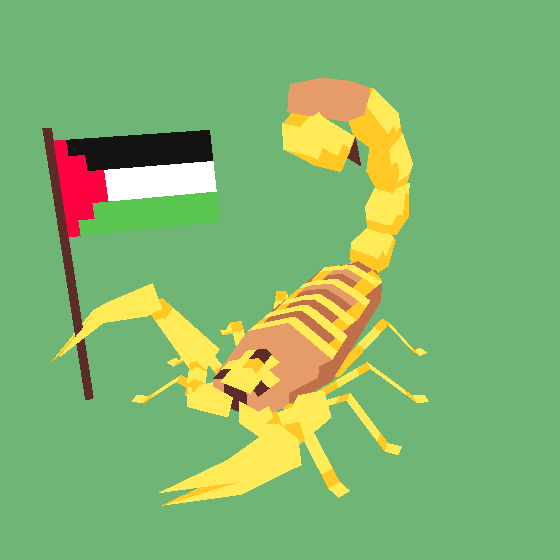
did you know? the deathstalker scorpion is also known as the Palestine yellow scorpion, and is widespread throughout occupied Palestine!
want me to model a creature of your choice in 3D, or see how i make things like this? i'll be streaming requests in exchange for donations as part of Drawings for Gaza! we'll be live at the following times:
Monday, Feb 19th at 10PM EST
Friday, Feb 23rd at 2PM EST
Sunday, Feb 25th at 6PM EST
the genocide in Gaza is getting worse every day, and no resistance is too small. educate yourself; call your local representatives; buy eSIMs so people can stay connected; donate to Operation Olive Branch, UNRWA, or PCRF; don't look away, and don't stay silent!
#free palestine#palestine#scorpion#deathstalker#3d art#lures you in with cool bug facts. go help people#gif#bugs#scorpions
9K notes
·
View notes
Text
Wool-Carder Bees: these solitary bees harvest the soft, downy hairs that grow on certain plants, rolling them into bundles and then using the material to line their nests

Wool-carder bees build their nests in existing cavities, usually finding a hole/crevice in a tree, a plant stem, a piece of rotting wood, or a man-made structure, and then lining the cavity with woolly plant fibers, which are used to form a series of brood cells.
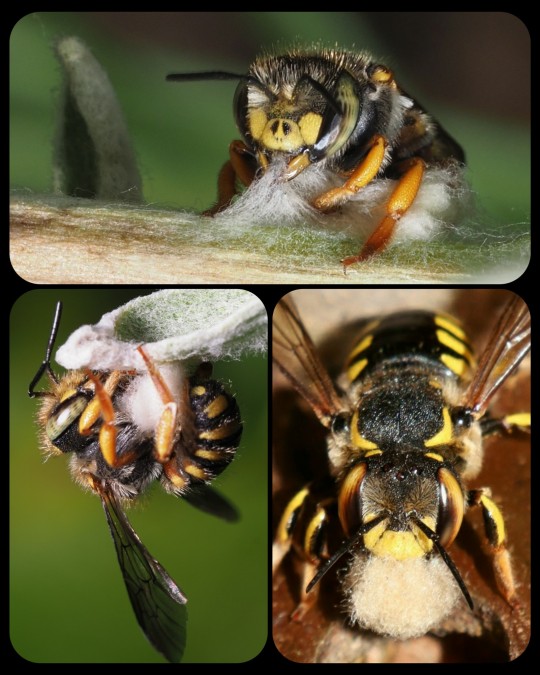
The fibers (known as trichomes) are collected from the leaves and stems of various plants, including lamb’s ear (Stachys byzantina), mulleins, globe thistle, rose campion, and other fuzzy plants.

From the University of Florida's Department of Entomology & Nematology:
The female uses her toothed mandibles to scrape trichomes off fuzzy plants and collects a ball of the material under her abdomen. She transports these soft plant fibers to her selected nest site and uses them to line a brood cell. Next, she collects and deposits a provision of pollen and nectar into the cell, enough pollen to feed a larva until it is ready to pupate. Lastly, she lays a single egg on top of the pollen and nectar supply before sealing the cell. ... She will repeat this process with adjoining cells until the cavity is full.
These are solitary bees, meaning that they do not form colonies or live together in hives. Each female builds her own nest, and the males do not have nests at all.
Female wool-carder bees will sometimes sting if their nest is threatened, but they are generally docile. The males are notoriously aggressive, however; they will often chase, head-butt, and/or wrestle any other insect that invades their territory, and they may defend their territory from intruders up to 70 times per hour. The males do not have stingers, but there are five tiny spikes located on the last segment of their abdomen, and they often use those spikes when fighting. They also have strong, sharp mandibles that can crush other bees.
There are many different types of wool-carder bee, but the most prolific is the European wool-carder (Anthidium manicatum), which is native to Europe, Asia, and North Africa, but has also become established as an invasive species throughout much of North America, most of South America, and New Zealand. It is the most widely distributed unmanaged bee in the world.
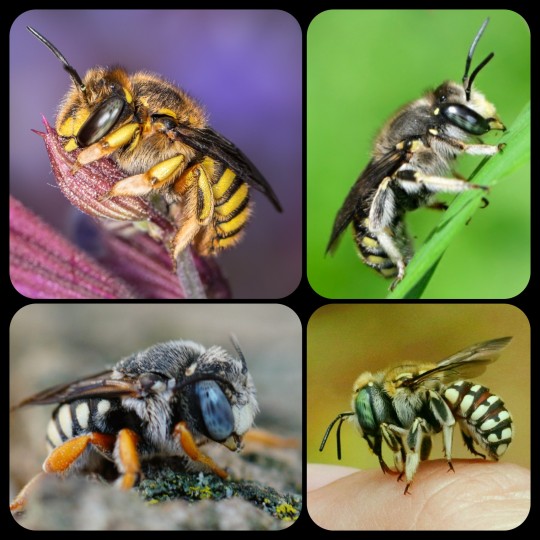
A few different species of wool-carder bee: the top row depicts the European wool-carder, A. manicatum (left) and the spotted wool-carder, Anthidium maculosum (right), while the bottom row depicts the reticulated small-woolcarder, Pseudoanthidium reticulatum, and Porter's wool-carder, Anthidium porterae
Sources & More Info:
University of Florida: The Woolcarder Bee
Oregon State University: European Woolcarder Bees
Bohart Museum of Entomology: Facts about the Wool Carder Bee (PDF)
Bumblebee Conservation Trust: A. manicatum
World's Best Gardening Blog: European Wool Carder Bees - Likeable Bullies
Biological Invasions: Global Invasion by Anthidium manicatum
#entomology#hymenoptera#apiology#melittology#bees#woolcarder bees#nature#insects#arthropods#science#solitary bees#european woolcarder#anthidium#animal facts#cool bugs#cute animals
3K notes
·
View notes
Text
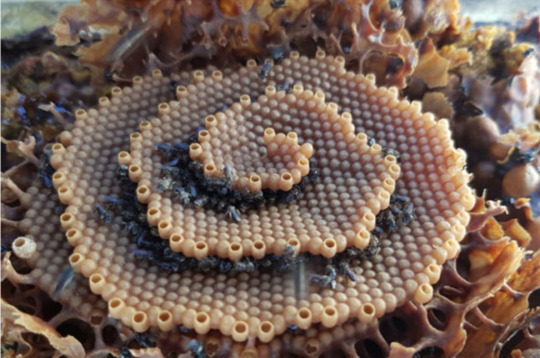

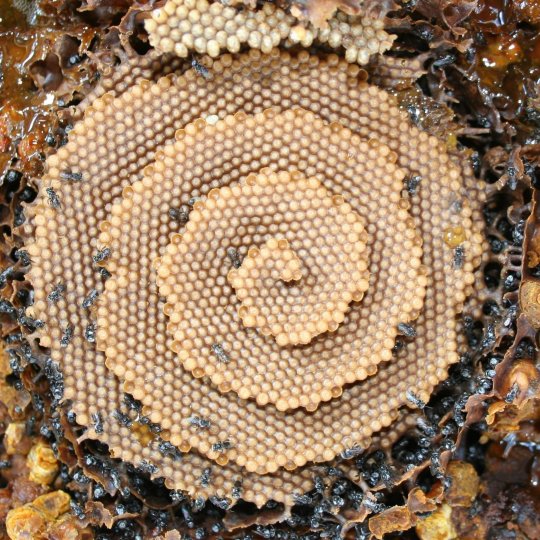
Fun fact: the stingless bees Tetragonula carbonaria can make beautiful spiral structures in their hives to house their young!
Source: Tim Heard, for a paper on how this mimics crystal growth
14K notes
·
View notes
Text

so i finally watched good omens after years of putting it off. . .
this is how i cope with most things
#good omens#good omens 2#aziraphale#crowley#i saw that one cat image and sent it to some friends n jus said 'crowley @ angel' then i was compelled to draw it#ouuughh the ggay influence#dont ask why hes on the floor#i didnt wanna draw a whole new bg that made sense#fun bug fact i had to use myself as pose ref for this cause i couldnt find anything i wanted so i just lied on my floor n took them
8K notes
·
View notes
Text

I wonder if she’s out there
#I want to meet non-bug Jane Prentiss#bug wife#cool bug facts#tma#the magnus archives#tmagp#the magnus protocol#jane prentiss#the corruption#horror#podcast#rusty quill#art#fanart#meme#tw trypophobia
2K notes
·
View notes
Text
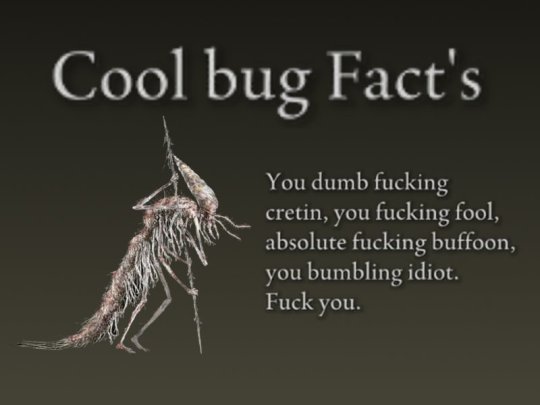
5K notes
·
View notes
Note
You've been isekai'd to the fictional world of what you last played, read or watched (whatever was the most recent option)…what was it, would you survive and what would you do in it?
last fictional world i dabbled in was Tears of the Kingdom and thankfully i survive because most npcs are indestructible
as for what i would do ... probably be menaced by bees. maybe open a second branch of the dye shop?? (full dyes when) or ..
wait
NO
waIT NO WAiT i take it back
I AM OPENING UP A HEADPIECE SHOP!!!!!!!!
botw and totk are fun but the negative fashion points given by most headgear is just. such a travesty. I am going to be the change I want to see in that world and offer alternatives for people who don't want to wear a fantasy traffic cone on their head.
this did remind me that i've actually been sitting on some art i gotta finish with this exact concept in mind

(^ part 1/? drawing)
#joey babbles#i would definitely romance beedle though#prepare urself little man i'm COMin for u and your stupid bug facts#tears of the kingdom#totk#breath of the wild#botw#link#sandflakedrew#loz
3K notes
·
View notes
Text




polymer broadcast signal hijack
#pikmin#captain olimar#ft. louie captain shepherd and collin#as well as#moss (pikmin)#watched a stream series of pikmin 4 (its frankenbugs' series) thats what this is about really#but mostly. I just love olimar. I just really enjoy that man#also this really got me flexing those bande dessinée muscles from back thens lol#Ive missed drawin with this kinda proportions... I should do it more#Im gonna draw an olimar to put in my wallet. I need to make my life harder to explain to strangers#I also wanna. add more details to his space suit. make it look more like real life space suit for fun & entertainment#man I enjoy the animals in pikmin so much. they really are just like. animals. theyre animals#its great I love how genuinely bug-lookin the bugs are even with the stylization. pikmin and pokemon are really good at that#would like to learn how to do that... sometimes in the future#oh yeah fun fact. my effort at cleaning up my undercut a few days ago went badly. right before I went to a family reunion thing for 2 days#so I was goin out of my mind at that event postin abt olimar bc I love him#and then. when I got home. I decided to shave my head instead of trying to fix the haircut again#and so the sequence of events becomes I post about olimar -> I enter my bald arc#I am okay with this. have a good night lads. binding books is actually really fun u should try it
2K notes
·
View notes
Text



#columbo#season 6#old fashioned murder#this has been your columbo history lesson#''stuck in the museum for 7 hours'' columbo is one of my favorite flavors of columbo#bug eyed and fact spouting#peak autism creature
4K notes
·
View notes
Text
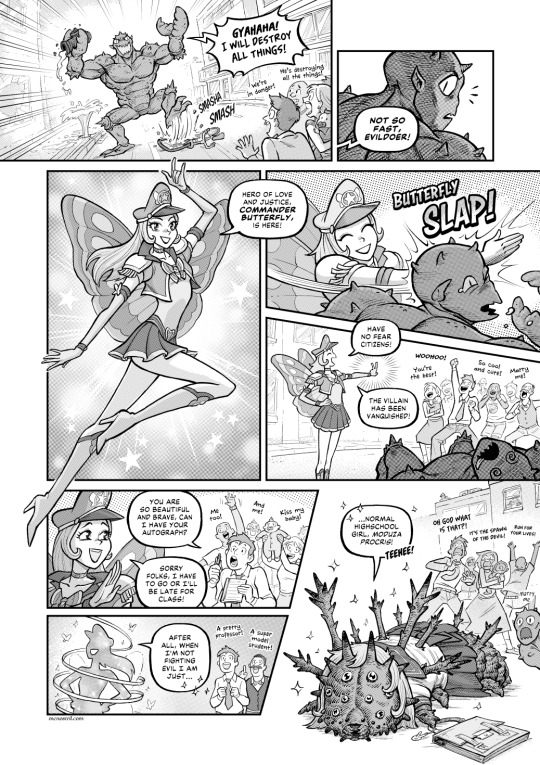
Have no fear, Commander Butterfly is here!
Save that fear for later when you learn more butterfly facts.
2K notes
·
View notes
Text
At a glance, you might think you can easily distinguish a butterfly from a moth. But take a closer look. There are colorful moths and day-flying moths that can throw you for a loop! Next time you come across a member of the Order Lepidoptera, use these tips from Insectarium host Dr. Jessica L Ware.
Learn more about butterflies in Insectarium on the PBS Terra YouTube channel.
#science#amnh#nature#natural history#animals#video#did you know#fun facts#butterflies#butterfly#moths#moth#lepidoptera#entomology#bugs#fact of the day#cool animals
603 notes
·
View notes
Text

drew arthur with a little friend. they're talking about life and death
#rdr2#rdr2 fanart#barghestland#arthur morgan#art#artists on tumblr#this week life was so fucking horrible i'm on the edge of having a little breakdown#and when im sad and stressed and done with life i just draw arthur#cuz his depressed ass would understand#u know.. yeah :(#i hope whoever reads it is having a better time#if u want u can tell me smth nice in tags or anywhere really<3#like tell me silly names of ur pets or facts about ur favorite bugs#i'd be happy to hear that
2K notes
·
View notes
Text
The Camouflaged Looper: these caterpillars fashion their own camouflage by collecting flower petals/vegetation and using silk to "glue" the pieces onto their bodies
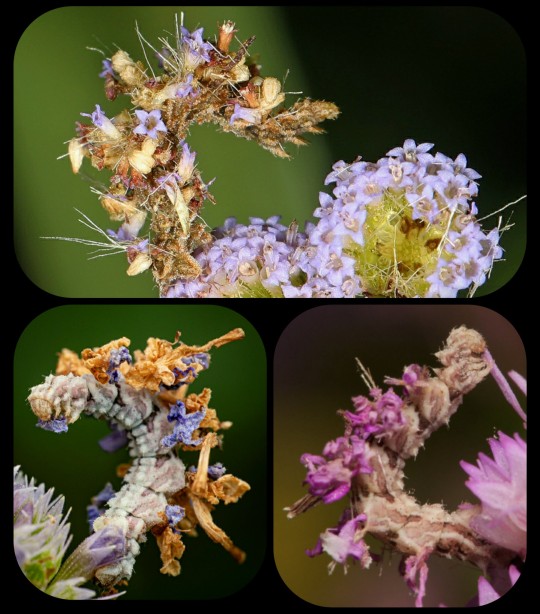
Often referred to as "camouflaged loopers," the caterpillars are the larvae of the wavy-lined emerald moth (Synchlora aerata).
Camouflaged loopers deploy a unique form of self-defense -- they snip off tiny pieces of the flowers upon which they feed, then use bits of silk to attach the vegetation to their backs. This provides them with a kind of camouflage, enabling them to blend in with the plants that they eat.

Some of them create little tufts that run along their backs, while others fashion a thicker camouflage that covers their backs completely. In some cases, the camouflaged loopers will even build much larger bundles that surround their entire bodies.
Their range includes most of North America (from southern Canada down through Texas) and they can feed upon an enormous variety of plants, so the disguises that these caterpillars build can come in countless colors, shapes, and sizes, incorporating many different flowers and other plants.

And this is what the fully-developed moth looks like:
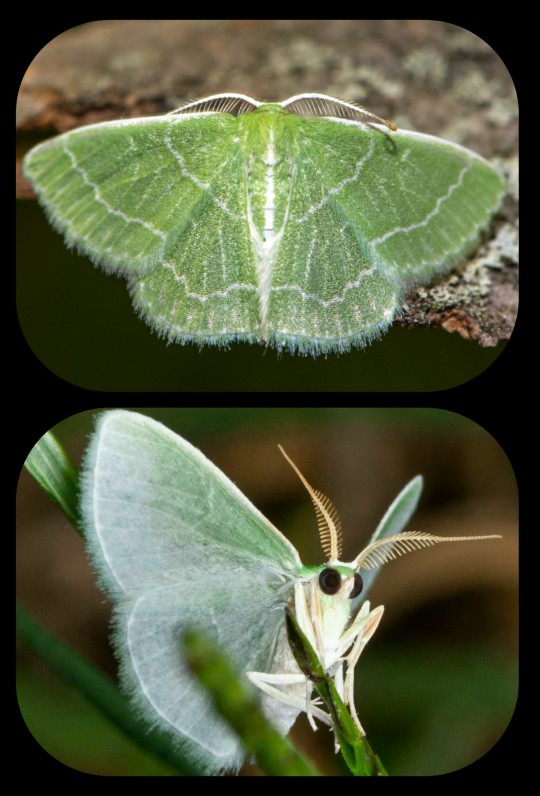
Sources & More Info:
Loudoun Wildlife Conservancy: Wavy-Lined Emerald, Master of Disguise
Maryland Biodiversity Project: Wavy-Lined Emerald Moth (Synchlora aerata)
The Caterpillar Lab: Camouflaged Looper
University of Alberta Museums: Synchlora aerata
Missouri Department of Conservation: Wavy-Lined Emerald
Nebraskaland Magazine: The Amazing Camouflaged Looper
Lake County Forest Preserves: Camouflage Revealed
#lepidoptera#moths#insects#caterpillar#camouflaged looper#animal camouflage#cute bugs#tw bugs#fashion#nature is weird#animal facts#these literal larvae have better fashion sense than I do
7K notes
·
View notes
Text

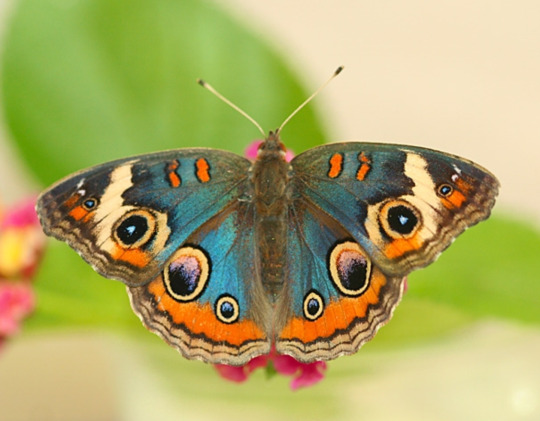
Fun fact: common buckeye butterflies (Junonia coenia) can be selectively bred to be blue fairly easily!
It turns out the only thing needed to go from brown to blue is a slightly thicker lamina, which is a flat layer at the bottom of the wing scale:
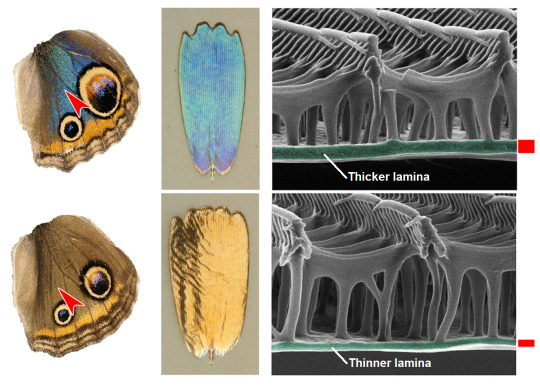
The lamina's iridescence is caused by the same phenomena as soap bubbles: thin-film interference. When light hits the transparent film of the lamina, it reflects off both the top and bottom of the layer.
Depending on the thickness and refractive properties of the material, the two reflected light waves can be in sync (image below) or cancel each other out. At the perfect thickness, the blue waves of light are enhanced and the butterfly becomes iridescent!

Because the difference in thickness needed to cause iridescence is so slight, it took less than a year to shift a population from just a few blue scales to full-on fabulous blue.
Photos & figures by Rachel Thayer, Nipam Patel, and Edith Smith.
#fun facts#structural color#iridescence#butterflies#buckeye butterfly#insects#bugblr#I just love shiny bugs
3K notes
·
View notes
Text
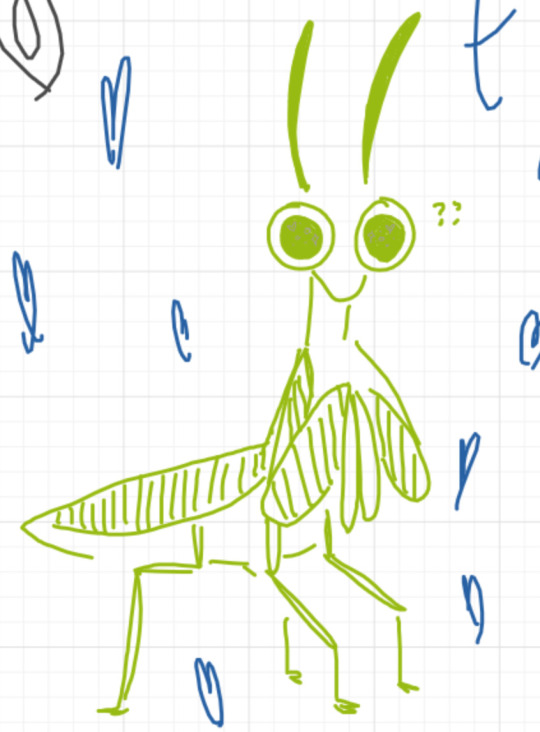


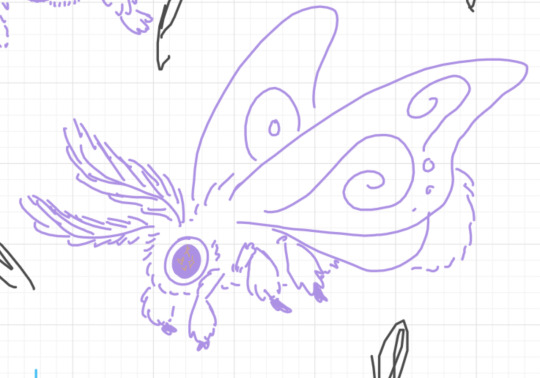
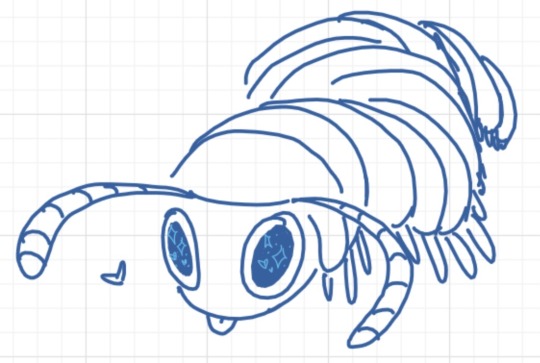
WHITEBOARD BUGS!!!!
#i love drawing lil cute bugs fun fact#my school notebooks were Littered with honeybees#i enjoy it! theyre cute! its soothing!#i like giving them cute lil tongues! Blep!#scribble salad#bugs#insects#digital art#im developing a deep fondness for millipedes#i had another one in my house the other day! a Guest!#i finally fulfilled my dream of holding one <3#theyre so cute.... little train bugs... choo choo....
892 notes
·
View notes